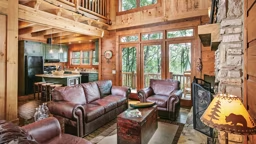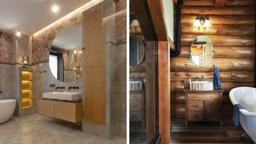
Run your hands along the rough surface of weathered timber, and you can feel the stories of decades gone by. Reclaimed wood and other salvaged materials are brimming with the kind of character and individuality that imbue a new home with a sense of time and place.
“Reclaimed materials have a history,” explains Zac Guy, CEO of Appalachian Antique Hardwoods. “People love to connect with the land and history. It creates a deeper enjoyment of your home. Plus, it’s the epitome of recycling.”
It’s true — these materials are more than a style statement. Using salvaged supplies conserves resources and keeps them out of the trash. Stylish and sustainable, the choice is a win-win.
From unusual origins to creative applications, reclaimed materials can take your custom design to the next level. Here’s what to know.

rock fireplace with a raised hearth lend this great room a rustic feel. The mantel is a
reclaimed, hand-hewn elm timber attached with bridge washers to which rust patina was
applied to simulate aging. Architect: Reid Smith Architects; Interior Design: Design
Associates; Builder: Teton Heritage Builders. Photo by Whitney Kamman
Wonderful Wood
In the reclaimed-materials realm, wood is, by far, the most familiar. Rugged, strong and warm, it possesses a highly desirable aesthetic that simply cannot be duplicated with new or faux options.
As architect Bill Tabberson, founder and owner of Tabberson Architects, puts it “Reclaimed [wood] is not just a look; it’s a spirit, a connection and a respect for reusing and keeping it out of the landfill,” he says.
Most reclaimed wood comes from old barns, fencing and other structures, but not always. Zac notes two unusual sources worth knowing in particular.
Mushroom board, available from Appalachian Antique Hardwoods, comes from the wood used in commercial mushroom farming. In fungiculture, the wood holds the compost that grows the mushrooms. It emerges with a beautiful brown color and a slight washboard effect attributed to the compost’s acidity. The final result is incredibly durable, naturally repels bugs and possesses inimitable color and texture.
Another reclaimed wood product from Appalachian Antique Hardwoods, RadialWood, comes from a fleet of World War II shipping pallets that were used (and reused) during the war effort. “This wood has a super-special story; I even have black-and-white photos of the military men using the pallets,” Zac says.

Metal & Brick
Alongside timbers in old barns, you’ll often find corrugated sheet metal. Bill harvests this metal from the siding and roofing and gives it new life. “The texture of seasoned metal is phenomenal,” he notes.
“Experienced brick” is another vintage treasure rich with character and potential. Bill prefers bricks that date pre-1950 because they were made in molds, are solid and have varying textures and consistency due to a different firing technique and composition. Even “newer” reclaimed bricks have a distinct, attractive patina.

Reclaimed Style
Every square foot of your new home presents an opportunity to showcase the rustic elegance of reclaimed wood, metal and brick. Here are a few ideas to get you started:
- Ceiling Trim. Bill recommends trimming the edges of a flat ceiling in reclaimed timbers and running the beams across the ceiling. For an authentic presentation, he encourages dovetail notching or visible pockets from mortise-and-tenon joinery.
- Ceiling Cladding. Ceilings don’t have to be bland. Reclaimed metal or wood enriches a ceiling and brings depth to the space. Lindsay Birnbaum, showroom sales manager and interior designer at reclaimed wood supplier Beam and Board says, “Many people like to add a feature of barn board in their tray ceilings or even cover the entirety of a vaulted ceiling. The most common [selections] are gray and brown, however, some barns are painted, and that gives it a real pop.”
- Shelving & Mantels. Replacing shelves or the fireplace mantel with reclaimed wood is a simple way to add instant character to a home. Lindsay explains that a beam’s unique cracks, knots and textures establish an authentic feel and warmth. With a mantel, she adds, “You bring back the focal point to a room.”
- Furniture & Lighting. Not just for the vertical and horizontal surfaces in your home, reclaimed materials make for extra-special furnishings as well. For example, Bill likes using 3-inch planks with lots of weathering for desktops. Beam and Board seeks timbers with carvings and incorporates them into accent pieces. Also worth consideration: cabinetry with reclaimed metal doors, timber beam lighting fixtures and handcrafted reclaimed wood tables — all of which can fit any style.
- Accent Walls. A single accent wall gives a home extra panache. Whether your home’s style is rustic, rugged, industrial or modern — a wood, brick or metal wall brings dimension, texture and interest.
- Doors. Trim a door with reclaimed metal for an extra stylish zing or have a barn door custom made with reclaimed wood.

frame was sourced from an Ohio barn. Overhead in the dining room, a custom light fixture
is made from a hay harpoon that was sourced from the very same barn. Architect: Ross
Anderson, AIA; Builder: Lee Building Company. Photo by Heidi Long
Getting Really Creative
As you can see, with reclaimed materials, the possibilities are boundless, so don’t hesitate to really think outside the box. Here are three more ways to give deserving castaways a new purpose in life.
- Bicycle Vanity. If you don’t need the cupboard space, make a statement by enlisting a beloved, vintage bicycle to support a sink and countertop. Bonus points if you use the basket to store towels.
- Industrial Irrigation Pipes. If exposed infrastructure is part of your home’s style, you can turn the HVAC system into something with history and aesthetics. One timber frame homeowner recruited antique agricultural irrigation pipes for the job.
- Factory Glass. At the turn of the century, special fire-resistant glass was required by code in schools, offices and apartments. Embedded with wire and sporting different colors and textures, these salvaged glass panels are now a clever way to divide a room.
Armed with these tips and tricks, you’re well on your way to achieving the perfect mix of imperfections.











